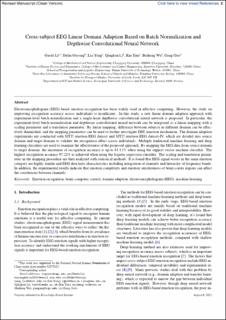| dc.contributor.author | Li, Guofa | |
| dc.contributor.author | Ouyang, Delin | |
| dc.contributor.author | Yang, Liu | |
| dc.contributor.author | Li, Qingkun | |
| dc.contributor.author | Tian, Kai | |
| dc.contributor.author | Wu, Baiheng | |
| dc.contributor.author | Guo, Gang | |
| dc.date.accessioned | 2023-12-28T08:52:39Z | |
| dc.date.available | 2023-12-28T08:52:39Z | |
| dc.date.created | 2023-10-20T12:42:35Z | |
| dc.date.issued | 2023 | |
| dc.identifier.citation | Knowledge-Based Systems. 2023, 280 . | en_US |
| dc.identifier.issn | 0950-7051 | |
| dc.identifier.uri | https://hdl.handle.net/11250/3108950 | |
| dc.description.abstract | Electroencephalogram (EEG)-based emotion recognition has been widely used in affective computing. However, the study on improving recognition accuracy across individuals is insufficient. In this study, a new linear domain adaption approach with experiment-level batch normalization and a single-layer depthwise convolutional neural network is proposed. In particular, the experiment-level batch normalization and depthwise convolutional neural network can be integrated as a linear mapping with a scaling parameter and a translation parameter. By linear mapping, difference between subjects in different domain can be effectively diminished, and the mapping parameters can be used to further investigate EEG emotion mechanism. The domain adaption experiments are conducted with SJTU emotion EEG dataset and SJTU emotion EEG dataset-IV, which are divided into source domain and target domain to validate the recognition effect across individuals. Multiple traditional machine learning and deep learning classifiers are used to examine the effectiveness of the proposed approach. By mapping the EEG data from source domain to target domain, the increment of recognition accuracy is up to 61.11% when using the support vector machine classifier. The highest recognition accuracy 97.22% is achieved when using the logistic regression classifier. The scaling and translation parameters in the mapping procedure are then analyzed with statistical methods. It is found that EEG signal waves in the same emotion category are highly similar and EEG data have characteristics including integration of channels and hierarchy of frequency bands. In addition, the experimental results indicate that emotion complexity and emotion sensitiveness of brain cortex regions can affect the correlations between channels. | en_US |
| dc.language.iso | eng | en_US |
| dc.publisher | Elsevier | en_US |
| dc.rights | Attribution-NonCommercial-NoDerivatives 4.0 Internasjonal | * |
| dc.rights.uri | http://creativecommons.org/licenses/by-nc-nd/4.0/deed.no | * |
| dc.title | Cross-subject EEG linear domain adaption based on batch normalization and depthwise convolutional neural network | en_US |
| dc.title.alternative | Cross-subject EEG linear domain adaption based on batch normalization and depthwise convolutional neural network | en_US |
| dc.type | Journal article | en_US |
| dc.type | Peer reviewed | en_US |
| dc.description.version | acceptedVersion | en_US |
| dc.source.pagenumber | 0 | en_US |
| dc.source.volume | 280 | en_US |
| dc.source.journal | Knowledge-Based Systems | en_US |
| dc.identifier.doi | 10.1016/j.knosys.2023.111011 | |
| dc.identifier.cristin | 2186742 | |
| cristin.ispublished | true | |
| cristin.fulltext | postprint | |
| cristin.qualitycode | 2 | |

